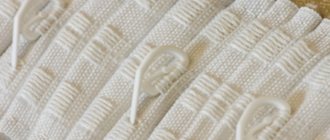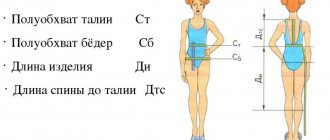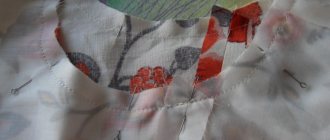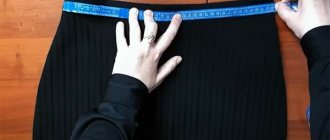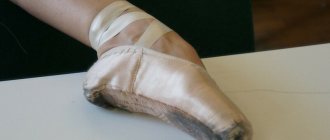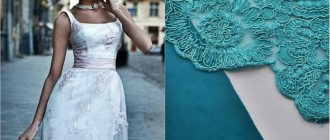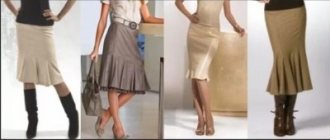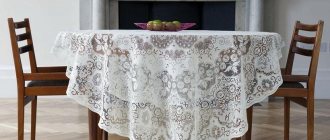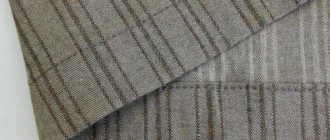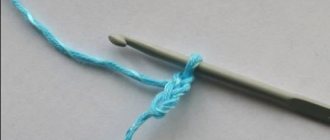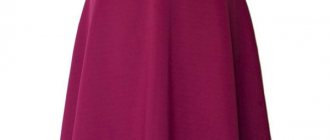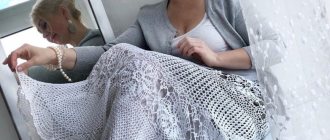Materials for decorating a skirt. Options for decorating a black skirt. Ways to decorate a knitted skirt. Tips on how to decorate a denim miniskirt. Tulle skirt decoration. Options to decorate a straight skirt and a pencil skirt. Decorating a maxi skirt. Decoration of a tulip skirt and a year. Decoration of a flared skirt.
In this article we will tell you:
- Materials for decorating a skirt
- Options for decorating a black skirt
- Ways to decorate a knitted skirt
- Tips on how to style a denim miniskirt
- Tulle skirt decoration
- Options to decorate a straight skirt and a pencil skirt
- Decorating a maxi skirt
- Decoration of a tulip skirt and a year
- Flared skirt decoration
Imagine that you see a skirt in a store. It seems perfect and you buy it without a doubt. Having tried it on at home, you come to the conclusion that it is good, but at the same time some detail is missing to make it perfect. And it also happens that you already have a skirt and have been wearing it for a long time. I like it, but would like to update it.
Every woman has things lying in the back corner of her closet that don't fit or are out of fashion. It would be a shame to throw it away - what if it comes in handy? What's the best way to proceed? It’s not so easy to instantly shape your figure, but it’s quite possible to turn outdated things into stylish ones. In this article we will give simple tips on how to decorate a skirt.
Sew lace ribbon to the skirt
It is not necessary to turn to a professional seamstress to decorate your wardrobe. You can become your own fashion designer. To sew an openwork fabric, you need to arm yourself with the following tools:
- scissors;
- needle and thread or pins;
- sewing machine
Selecting lace
To finish the bottom of the skirt, you can choose an openwork pattern to match the material of the skirt or use contrasting colors . The openwork of one of the colors of the fabric of the item will suit multi-colored fabrics.
Whether to use natural or synthetic lace fabric depends on taste and budget.
The width of the canvas can vary. A thin stripe will make the item more elegant, while a wide stripe can lengthen the hem to the floor.
Important! Lace trim works well on almost all types of fabrics, from silk to denim. The only exception is wool: with it, openwork delights look tacky.
Decorate the bottom of the hem with lace
The general algorithm looks like this
- We apply the lace to the base to choose how to place the openwork fabric: on top of the main one or under it.
- We measure and cut off the required amount of lace ribbon, leaving a margin of one centimeter.
- We apply lace to the pre-finished zigzag or overlock bottom of the skirt and baste it (or pin it together). It is necessary to ensure that the hem is not pulled down!
- We sew lace along the edge of the pattern using a machine..
- If necessary, cut off excess fabric. If sewing was used, we process the cut.
Important! It is best to choose a zigzag stitch: it will protect the fabric from “wrinkling”.
Flared skirt decoration
How to decorate a skirt of this type: make a neat tulle lining. The stencil for such a lining is usually taken from a circle skirt. Please note: the length of the diameter of the waist line of the lining and the length of the diameter of the waist line of the main product must be the same. In addition, the lining must be made so that it is five centimeters larger than the skirt. The prepared tulle lining should be evenly attached to the inside of the product. A beautiful tulle bow will add playfulness to the resulting image.
An excellent solution is lace flowers. Here you need to take an outline frame, outline it and cut out the lace shape of the flower with your own hands. Contrasting warm shades are perfect: orange, red, yellow. But it is better to decorate the center in other colors.
Now you need to put together a decorative composition and sew or glue a rhinestone, gold leaf, or beads into the center of the flower. The final stage is the placement of the accessory on the main product. You can decorate the hem of a knitted circle skirt with leather elements (width - from five to seven centimeters). In addition, beads arranged in an orderly manner on its front part (diameter - from six to eight millimeters) are perfect for this type of product.
Most representatives of the fair sex have several skirts in their wardrobe. These products focus attention on the graceful curves of the female figure. Perhaps among your things you can find a couple of similar items of clothing that have lost their presentation, become boring, outdated. Don’t rush to throw them away - try experimenting and decorating your skirt.
Working with lace: useful tips
- Lace ribbon can “shrink” like any fabric. So that all the work does not go down the drain after a couple of washes, we prepare the fabric in advance . We moisten, dry, iron from the inside out. A steam iron will also work.
- We select threads depending on the method of arrangement of the part . Should we place the lace detail on top of the hem? The threads should match the color of the trim. Will the fabric lie on top of the lace strip? Then the threads are matched to the color of the dress.
- Sometimes lace fabric requires handwork . You will have to do without a machine when working with knitwear. The lace with a figured edge is also sewn on by hand.
- The junction of the trim with the hem can be additionally decorated with sequins and rhinestones, beads and thin braid.
Even a narrow openwork stripe decorating the bottom of your skirt will help it look new.
Open the Circle Skirts
Fold the fabric in half across the warp threads. You should cut by placing the pattern with a diameter on the fold line and securing it with pins. If you did not make hem and waist seam allowances on the pattern, you can apply them directly to the fabric, setting aside the required distance from the paper.
The length of the allowances will depend on the type of seam chosen for processing. It’s better to make the allowances a little larger so that you can adjust the final details if the measurements are inaccurate.
Now you should cut out the skirt, grabbing all the fabric with scissors. As a result, you will get the required circle. We cut it along the fold line of the fabric on one side: the zipper will be sewn in at this point.
The next stage of creating a pattern is trying it on. A mannequin will help you a lot. Place the future skirt on it and let it hang. Since the skirt is cut on the bias, the warp and weft threads of the fabric may be slightly deformed.
The skirt should hang down
Once the skirt has dropped, if necessary, trim the hemline of the skirt with sharp scissors, applying a paper pattern to it.
Secrets of sewing lace
Dresses and blouses decorated with lace look airy and certainly attract the eye. However, sewing openwork lace onto products is not so easy. If you do this work, do it with the utmost care and precision, because the first glance of every person you meet falls on the lace.
By following the advice of experienced craftswomen, you will do this job correctly:
- Wash the linen because it can shrink and tighten the fabric. To preserve the relief, lay it “face down” on a soft surface and go over it with an iron. You can simply iron it with a steamer.
- When sewing the decoration simply to the fabric, place it overlapping the edge of the fabric, baste it, and sew it on a zigzag machine. Always match the threads to the tone of the openwork.
- If you are making lace gathers, then first make them on the lace, then baste them to the product and sew them on a machine with a zigzag seam.
- You can make folds on the lace ribbon. Choose a base with an alternating pattern, lay out the pleats according to the pattern, baste, and then machine sew.
How to sew lace elements together:
- Take the base with a reserve, then cut out the design along the contour.
- Place one piece on top of the other so that the pattern on one piece matches the other.
- Fasten with needles in different places, baste along the entire contour, and then sew with a zigzag. You can do it manually, since the stitching area will be small.
Creative porridge
Good day to all! Today we will update a twenty-year-old skirt, return it to its current look, and also modernize it a little. Open grandma's chests and take out threads and needles - it's time for a change
Probably, each of us has old things at home that are out of fashion, but of acceptable appearance and good quality. These are skirts, trousers, coats and blouses from the Soviet period, carefully preserved by our grandmothers and mothers.
I came across a typical skirt for the era of the 80-90s: flared along the entire length, a small vent and zipper in the back, gathers in the front and two pockets on the sides. The material is wool, the pattern resembles a houndstooth. When they gave it to me, I immediately realized that I wouldn’t wear it like that. It turned out to be too long and wide for me.
I decided that I would cut it a little and cut it in at the sides, giving it the look of a pencil skirt. At this stage, as usual, things got busy, and the skirt was thrown to hell. After some time, I again returned to changing the skirt, but I rejected the idea of a pencil, since by that time a woolen pencil skirt with a large check had already taken up residence in the closet.
Later I decided that it would be a mid-length skirt with straps. After much fitting, I quickly cut off 10 cm and began hemming the edge. What came of it... quiet horror, the skirt was hopelessly ruined.
Today, I finally decided to give the skirt a normal look that I wouldn’t be embarrassed to wear. The main problem was the choice of style; I decided not to change the style of the skirt, but simply decorate its bottom with lace. I liked the following options from the Internet, and I wanted to create something similar.
This slideshow requires JavaScript.
- An old skirt, or you can sew it from scratch using any pattern from the Internet.
- Scissors.
- Sewing machine.
- Matching lace is 1.5m long.
- The threads are contrasting and match the tone of the product.
- Chalk.
- Needles, tailor's pins, centimeter.
Step one. Removing the length
We finally decide on the length of the skirt, use a centimeter to measure the required size, draw a border with chalk and cut off the unnecessary part. We operate according to the principle: Measure seven times, cut once.
Step two: Process the edge
You can use an overlocker or zigzag the edge.
Result:
At the same stage, we mark the allowance (any) to which our lace will be attached.
Step three. Trying on lace
On the marked line, place the lace (right side inward) so that the uneven edge is towards the waistband. We pin and mark with contrasting threads.
If we peel back the lace, we get the following look:
Step four. Machine sewing lace
We use a regular straight stitch, but not too small a stitch size so as not to pull the lace.
Step five. Blind stitch
After the lace is sewn, it is necessary to remove the basting stitches and thoroughly iron the product. Next, we bend our allowance and again make a basting of 0.5 cm.
How to lengthen a dress
The fashion for lace trim lasts for more than one season. If you are tired of a dress, then decorate it with sewing. You can also lengthen the product.
On a note!
To make the finish look especially beautiful, the fabrics must match in color or be contrasting. For a floral dress, choose decorative patterns to match one of the colors of the item's fabric.
You can sew to the hem in two ways:
- Openwork fabric is applied over the hem.
- The hem is sewn on top of the decor.
The openwork tape is cut with a margin (1-2 cm) to connect the parts. In the first case, lace is placed on the front side of the hem and a basting stitch is laid. A machine stitch is placed along the edge of the pattern.
In the second case, the openwork is applied to the bottom of the hem from the wrong side.
If you need to lengthen the dress, then choose a wide ribbon.
The lace fabric looks beautiful.
Decorating a maxi skirt
So, let's decorate the long skirt. Many fabric decorative elements are suitable: ribbon, lace patterns, chiffon or satin ribbons.
- The lace pattern is usually used either on the area where the strap would be or on the lower hem of a maxi skirt.
- A chiffon ribbon or ribbon can play the role of a thin bright belt.
- How to decorate a white linen maxi skirt: add a large brooch to the look, attached to the right or left side.
- In addition, a linen circle skirt will look more elegant with lace sewn to the bottom of the product and encircling it.
Sew openwork ribbon to the skirt
You can also adapt the ribbon to the skirt in two ways: on top of the hem and on the wrong side of the fabric.
Contrasting lace looks original.
The algorithm looks like this:
- Finish the bottom of the skirt with an overlocker, attach the openwork, and sew it on with a machine.
- Cut off the excess and process the cut with a zigzag.
- With knitwear it is better to do without a machine. Sew on a ribbon with a figured edge by hand, decorate the junction with the hem with beads, rhinestones, and thin braid.
How to make a pattern for a half-sun skirt
To create a pattern for a semi-sun skirt you will need only 2 measurements:
- length of the product;
- waist circumference (if you plan to sew a skirt with a belt) or hip circumference (if you plan to sew a skirt with an elastic band).
Important! The appearance of the finished product depends 90% on the correctness of taking measurements and the accuracy of calculations when constructing a pattern. Therefore, it is worth taking this seemingly simple process with all seriousness.
The main mistake many novice seamstresses make is neglecting the installation belts when taking measurements. Of course, it’s good when the figure is close to ideal and has clearly defined waist, hips and chest lines. However, in reality this is more an exception to the rule than a pattern, and the waist is not always the narrowest place on the body. This feature is especially visible among owners of:
- protruding bellies;
- shapes such as “apple” or “rectangle”;
If you want the finished product to fit perfectly on your figure, be sure to use the installation belt when taking measurements.
Procedure for taking measurements:
- Tie a thin, non-elastic band around the waist, strictly parallel to the floor surface.
- Measure the distance from the installation belt to the planned length of the skirt.
- Measure your waist circumference where the braid is located.
- Measure the volume of the hips at the most protruding points of the buttocks and thighs.
Record the received data in this way:
- DI – skirt length;
- OT – waist circumference;
- AB – hip circumference.
To create a pattern you will need to make basic mathematical calculations:
- Divide the waist and hip measurements in half. No arithmetic manipulations should be performed with measuring the length of the product.
- Calculate the depth of the notch (the distance from the top of the corner to the waist line) using the formula.
The formula is as follows:
SWEAT - ½ waist circumference;
2 number of pattern pieces;
2 cm – increase for loose fit;
Then you can start making the pattern:
- Construct a right angle and mark its vertex with point K.
- From t A, set aside the distance obtained as a result of calculations in both directions. Label the resulting points P and P1.
- Connect points P and P1 with a radius arc. For this purpose, you can use a compass with a large solution or regular braid with a pencil tied to it.
- From t Pi P1, set aside a measure on both sides equal to the length of the future skirt DI.
- Connect the resulting points with a radius arc. Please note that when drawing the lower radius (bottom of the skirt), the center should be t K, and not the upper arc (waist line).
At this point, the process of making a half-sun skirt pattern is considered complete, all that remains is to check the correctness of the construction. To do this, you need to measure the waist line on the drawing with a centimeter tape; it should be equal to half the waist circumference + 1 cm. Deviations of a few millimeters in any direction are quite acceptable, but if the deviation is much more significant, it is worth reviewing all calculations and construction stages.
Sew on figured and straight openwork
When sewing an insert made of straight fabric, baste it face up to the fabric and stitch closer to the edge. Cut out the material from the inside out, tuck the edges and hem with an over-the-edge seam.
On a note!
It is better to sew the figured ribbon by hand. Place it “face” to the fabric, baste along the curly edges with small stitches. Cut the fabric from the inside out and hem the edges.
Decorating clothes with lace
Any clothing can be updated if you decorate it with a piece of openwork. How to sew to shorts:
- Cut out a piece of decor, completely preserving the design.
- Make a slit or cut a piece of fabric along the side seam of the shorts.
- Attach a piece of decor, pin it in different places, and lay a basting stitch.
- Iron with a steam iron.
- Sew on a machine.
Decorate your blue jeans with white lace yourself. You will not buy such a beautiful thing in any store. In this case, the lace fabric must be placed from the inside out, then stitched along the entire perimeter.
On a note!
You can stitch the trim to the sleeves anywhere: along the bottom of the sleeve, along the shoulders, along the sleeve, in a word, as your imagination dictates. The procedure is the same as for the hem of the dress.
Contrasting trim on the sleeve will update and decorate any dress.
Updating a top or T-shirt with patterned fabric is easy. First, make folds on the lace ribbon, then sew it to the top.
- The folds can be ordinary, which go in one direction.
- Counter, when the canvas is folded towards each other.
- Bow ones. The material is also rolled up on both sides, but only in the opposite direction from each other.
If you fasten together several types of openwork material and sew it to a blouse, the product will take on a more elegant look.
Video text
✿This video in ENG
•●•●•●•●• How to update an old skirt? How to alter it so that you want to wear it and not throw it away? How can you even sew a skirt WITHOUT a pattern? And how will a skirt sewn without a pattern look?
So, we continue the series of issues on how to remake old clothes, on how to transform them without much effort and without investing money. This DIY issue in Russian will be another step towards beautiful DIY clothes in your wardrobe.
So, let's move from words to action. And yet, how to sew a skirt without patterns and without sewing skills? How to easily alter a skirt? In order to update an old skirt, we will need: 1) a skirt, preferably flared 2) a piece of any bright fabric measuring 6x100 cm 3) bleach and spray 4) wide tape 5) needle, scissors, thread
So, following the simple instructions in this video, you can easily transform an old boring skirt into a fashionable, interesting skirt. Sewing a skirt with your own hands is easier than you might think! Try it!
